
Kathmandu’s Aesthetic Charm Diminishing Amidst Concrete Jungle Expansion

Kathmandu, the cultural heart of Nepal, is experiencing a significant transformation as it grapples with the increasing presence of concrete structures. Traditionally renowned for its rich cultural heritage and stunning natural landscapes, the city is now at risk of losing its unique aesthetic appeal due to the proliferation of concrete construction.
Kathmandu, nestled within the Himalayas, is famous for its fusion of art, culture, and identity, drawing travelers and artists from all over the world. However, in recent times, this iconic city is witnessing a surge in concrete construction projects that are transforming its skyline.
The city’s expansion is most visibly marked by the rise of massive concrete skyscrapers. While they bring modernity and development, they also contribute to the gradual erosion of the city’s natural charm and historical character. Many residents and experts are concerned that the uncontrolled growth of concrete structures might overshadow the unique beauty and heritage of Kathmandu.
Furthermore, the once-lush green hills that used to surround the city are slowly disappearing, adding to the feeling of chaos that now characterizes Kathmandu. The loss of these green spaces not only affects the city’s aesthetic but also raises environmental concerns, such as increased pollution and heat island effects.
Residents and conservationists are increasingly calling for measures to balance the city’s growth with the preservation of its cultural and natural heritage. Local authorities are being urged to implement more stringent urban planning regulations that encourage sustainable and aesthetically pleasing development.
The fate of Kathmandu’s aesthetic appeal hangs in the balance as the city grapples with the challenges of balancing progress with preserving its rich heritage. As the concrete jungle continues to expand, there’s a growing need for careful and considerate development that can maintain the city’s unique charm and identity.














Comments